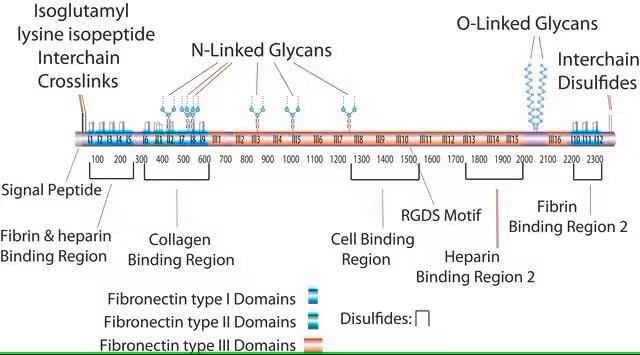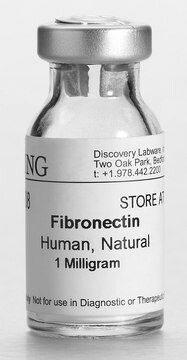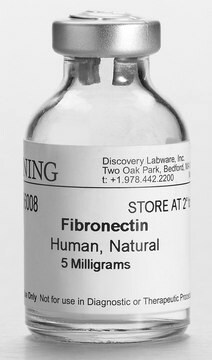F1056
Human Fibronectin
from human plasma, powder, suitable for cell culture
Synonyme(s) :
Fibronectin
About This Item
Produits recommandés
Nom du produit
Fibronectine, lyophilized powder, BioReagent, suitable for cell culture, ≥95% (SDS-PAGE)
Source biologique
human plasma
Niveau de qualité
Stérilité
sterile
Gamme de produits
BioReagent
Essai
≥95% (SDS-PAGE)
Forme
lyophilized powder
Conditionnement
pkg of 1 mg
pkg of 2 mg
pkg of 5 mg
Technique(s)
cell culture | mammalian: suitable
Couverture de surface
1‑5 μg/cm2
Solubilité
H2O: 1 mg/mL at 37 °C
Numéro d'accès UniProt
Spécificité de la liaison
Peptide Source: Collagen
Conditions d'expédition
dry ice
Température de stockage
−20°C
Informations sur le gène
human ... FN1(2335)
Vous recherchez des produits similaires ? Visite Guide de comparaison des produits
Description générale
Application
- in neural selection medium to coat tissue culture surface for neuronal differentiation
- to coat culture vessels for characterization of iPSC and iPSC‑derived BMEC in 2D cell culture
- to coat culture supports for endothelial cell culture
Actions biochimiques/physiologiques
Attention
Notes préparatoires
In coating culture surfaces, fibronectin should be diluted in sterile balanced sterile salt solution and coated with minimal volume. Surface should then be air dried for 45 minutes at room temp and can be stored for 2-4 weeks at 2-8°C.
Clause de non-responsabilité
Code de la classe de stockage
11 - Combustible Solids
Classe de danger pour l'eau (WGK)
WGK 3
Point d'éclair (°F)
Not applicable
Point d'éclair (°C)
Not applicable
Équipement de protection individuelle
Eyeshields, Gloves, type N95 (US)
Faites votre choix parmi les versions les plus récentes :
Déjà en possession de ce produit ?
Retrouvez la documentation relative aux produits que vous avez récemment achetés dans la Bibliothèque de documents.
Les clients ont également consulté
Articles
Extracellular matrix proteins such as laminin, collagen, and fibronectin can be used as cell attachment substrates in cell culture.
Protocoles
Dilute fibronectin to the desired concentration. Optimum conditions for attachment are dependent on cell type and application. The typical coating concentration is 1 – 5 ug/cm2.Fibronectin coating protocol, products, and FAQs.
Notre équipe de scientifiques dispose d'une expérience dans tous les secteurs de la recherche, notamment en sciences de la vie, science des matériaux, synthèse chimique, chromatographie, analyse et dans de nombreux autres domaines..
Contacter notre Service technique







